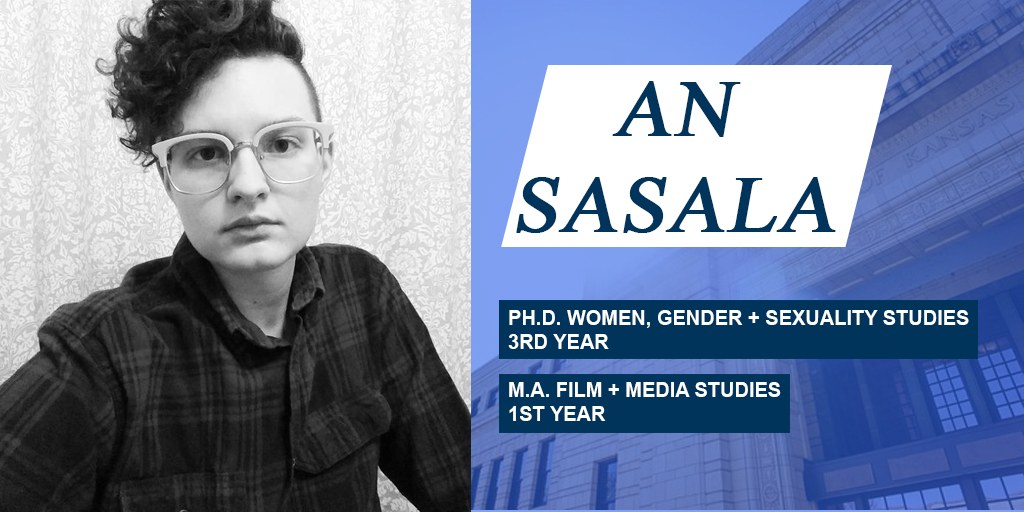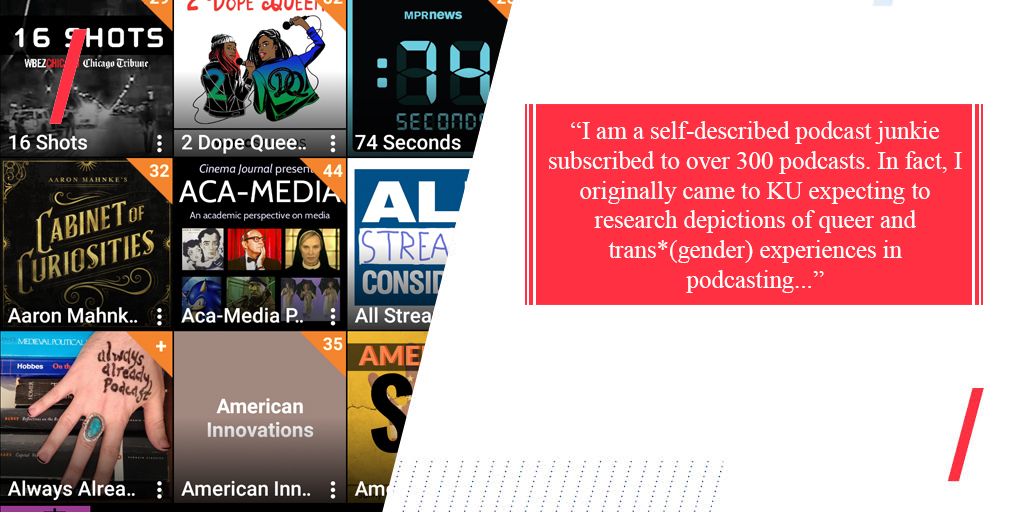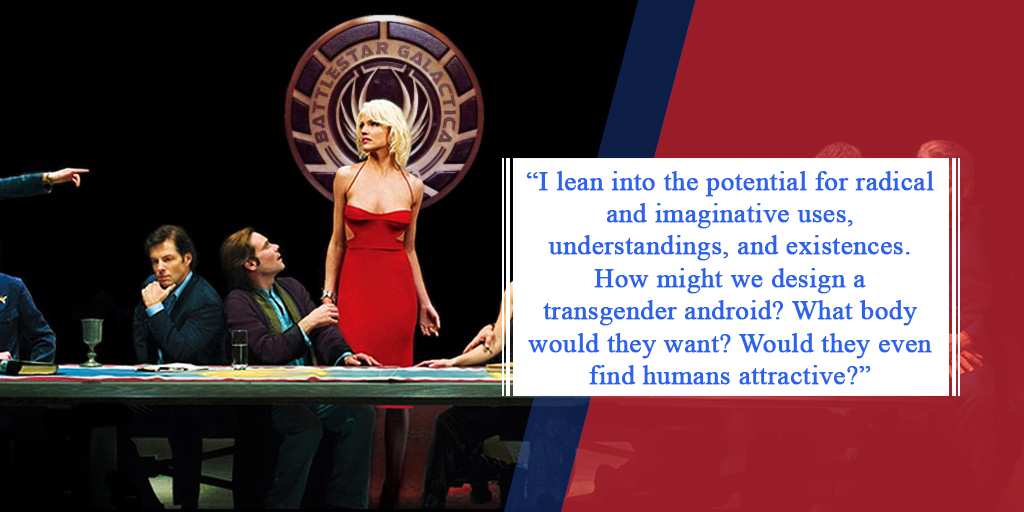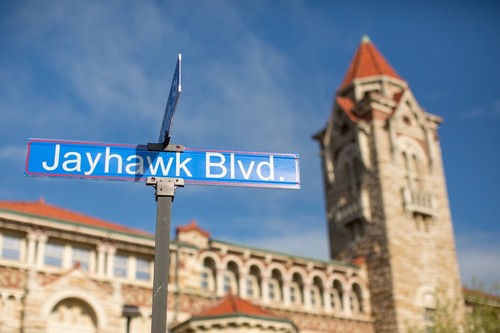
How are social norms about gender and sexuality perpetuated through portrayals of robots and other digital entities in sci-fi storytelling? What can these treatments in popular media tell us about the societies in which we live, and how can scholars challenge these narratives? An Sasala is taking up these questions through interdisciplinary, multimedia research exploring trans* and non-binary experiences in America’s Heartland, and challenging audiences to rethink ideas about the human body and technology.
Meet An, a third-year Ph.D. student in KU’s Women, Gender, and Sexuality Studies program and a first-year M.A. student in KU Film & Media Studies, and learn what they had to say about finding a community of collaborators at KU and using artistic expression as a tool for activism.
Hometown: Parma, Ohio
What are your research interests and why did you choose them? Was there a moment when you decided this is what you wanted to study? What was that journey like?
I am a self-described podcast junkie subscribed to over 300 podcasts. In fact, I originally came to KU expecting to research depictions of queer and trans*(gender) experiences in podcasting, but then things took about five left turns during my first Film + Media Studies (FMS) class. To put it otherwise, I cycled (rapidly) through multiple “Eureka!” moments and went down a rabbit hole from which I have yet to emerge.
The class—FMS 702: Body, Media, Environment—complicated how I understand virtualßàrealßàactual existences and pushed me to consider nonhuman life in relation to technology. Generally, I now study technological embodiment, or how digital bodies and persons (might) navigate the human world. In particular, I link science fiction film and media texts (Bladerunner 2049, the Halo videogames, Battlestar Galactica) to “IRL” tech developments and human experiences. I often ask: how does human discrimination shape the (acceptable) physical/material presence, expressed emotions, and other sense-based experiences of digital entities?

Tell us what your PhD thesis is in under 200 characters, make it Twitter friendly:
Note: I am still finalizing my project thesis, so this is more of a summary of the main concepts with the final sentence as a solid gesture towards a thesis. Also, I checked and this fits in a tweet!
Tyra Banks’ “Lifesize” but make it trans*inclusive, intersectional, and digital. I expand the way humans construct and conceptualize bodies in relation to technology via speculative films, transmedia storytelling + art. Transgender androids dream of radical futures.

What is one thing you think everyone should know about your research project or research interests? This might be a commonly held belief that your research questions or complicates.
As I am sure comes as no surprise, much popular media and science fiction storytelling tends to reproduce dominant social structures and oppressive norms. For example, we usually portray droids as emotionless workers-cum-tools capable of fixing every technological problem or as hypersexual, heavily gendered robots, usually heterosexual fembots. (see: Caprica-Six, the blonde bombshell cylon played by Tricia Helfer in Battlestar Galactica.) In my work, I first expose the norms inherent in these portrayals and designs (heterosexual, cisgender, white, slender, domesticated everywhere except the bedroom, differently abled in “advantageous” ways, located in middle and upper class society, etc.). After that, I offer examples which challenge and/or trample these norms. I lean into the potential for radical and imaginative uses, understandings, and existences. How might we design a transgender android? What body would they want? Would they even find humans attractive? While some science fiction askes their questions, their answers remain open, ready for my (and your) response.
Where are you conducting your research? In archives? In laboratories? What are your sources?
My dissertation will involve a written portion and a still-forming creative-critical media component.
Written Portion: This part places into conversation science fiction film and media which includes technologically nonhuman characters. A fairly traditional textual analysis, I will analyze sources through an interdisciplinary mesh created out of: trans* theory; science and technology studies; human-computer interaction studies and interface theory; gender studies and queer theory; and new media studies. I plan to include examples spanning television, film, experimental media and installation art, and video games.
Media Component: I plan to conduct interviews with trans* and non-binary folks living in the Midwest/Heartlands. Themes identified through these interviews will inform the narrative of my experimental installation or film. Direct quotations, along with video and audio footage, will appear in different scenes and/or form portions of written text or dialogue. I wish I could explain more, but please stay tuned for the finished dissertation.

What advice would you give students applying for research funding opportunities?
Be realistic with yourself about the scope and feasibility of your project—take into account your ability to commit time and emotion. I burned out quite spectacularly at the end of my second year because I never stopped to check-in with myself or to assess where I was with my projects. You can find plenty of advice on filling applications, but in my experience, you and the project will only find success if you took time to check-in with your emotions, priorities, and schedule. This also creates a chance for honesty and clarity—before the Imposter Syndrome sets in and you stare at a blank screen and blinking cursor for what seems like hours. I like to look at the application and then sit with it before going further so that I can be intentional instead of reactive.
Give a shout-out to a professor, mentor, advisor, or someone at KU who has helped you?
I struggle so much with picking a person to shout-out. For me, grad school is possible only through community and collaboration. If this were an Oscars speech I would thank:
- Trish Nixon, my partner, who asks tough questions and brings me chicken soup for body and soul.
- Abigail Barefoot, cohort member and best friend, whose ceaseless support and feedback (and her rainbow cupcakes) help me grow, constantly, and overcome moments of imposter syndrome-fueled doubt.
- Katie Batza, the advisor-mentor I followed to KU from Pennsylvania. Katie constantly pushes me to think critically and deeply. (Perhaps) without meaning to, Katie helped me build confidence with a simple bit of writing advice: Don’t use passive voice. Use active verbs, be assertive, and say what you mean.
*starts sobbing and is clapped off the stage.*

What is the most valuable experience you have had while studying at KU?
During summer and fall 2019, I made my first short film, something I honestly never imagined doing until graduate school. My film, I Have a Mouth Yet I Cannot Scream explores the emotions trans* and non-binary people experience when reduced to their appearance—do they “pass” as cisgender and move through the world safely. As the trans* protagonist stares down their viewer and screams, sound drops out, providing a commentary on the systemic silencing of trans* voices within the U.S.
In undergrad, I studied to be a traditional scholar who reads books, watches films, and analyzes them through theory. I did not realize until KU that I wanted to—and that I could!—make something which expresses, explores, and approaches my work in such a radically expressive, affective, and creative way. For the film, I performed in front of the camera, the most challenging and rewarding experience to date of my grad school career. In the past, I kept a nice, safe distance (academic and emotional) from my work—in part because I thought that’s what academics do, but mostly because I did not feel prepared to accept the responsibility of doing increasingly personal work. As actor, director, producer, and editor, I finally embraced my identity as artivist (artist-activist) and embodied my non-binary gender in a primarily visual way. In my life, I minimize my body in order to avoid misgendering and dysphoria—to fly under the radar. In performing, recording, and screening, I allowed myself to have a visible body, a body which experiences privilege and oppression and challenges unequal systems.

What do you plan to do after you graduate from KU?
After KU, I plan to pursue alternative and non-academic careers, preferably with a non-profit or public organization focused on technology, art, and/or community engagement. Instead of standing at the front of the room, I enjoy bringing in speakers and helping to create a space. I love witnessing events from the corner of the room, watching people’s faces light up when they learn something new, or perhaps more satisfying, when faces scrunch up when folks grapple with new ides, challenging questions, and their privilege. Working in a place where I can provide art and technology skills training to local communities is the first step towards my dream: founding a non-profit which provides film + media production classes and equipment to trans*, non-binary, and queer folks, especially youth so that they can explore who they are and tell their own stories.
I also plan to keep creating and producing art after grad school. Who knows, a TBD, multi-media installation piece may pop up at the Spencer one of these days.
What motivates you?
FOMO mixed with anxiety? In all honestly, I think we—academics, society, LGBTQ+ folks—spend too much time focused on representation and forget about material existence and effects. Yay, a trans* character survived the season of “Insert TV drama here!”, but I can still lose my job or house in the state of Kansas because my partner and I are both queer and trans*…
Be like An. Don’t be afraid to push the boundaries with your work and be realistic when it comes to your time and emotions. For more information about KU’s Film & Media Studies program, visit their web page and learn more about the opportunities they offer to students. Additionally, the same can be found for KU’s Women, Gender + Sexuality Studies program at their web page.